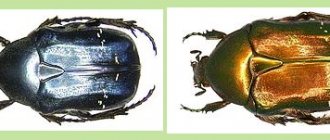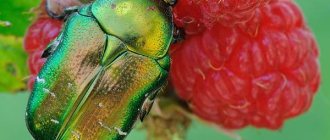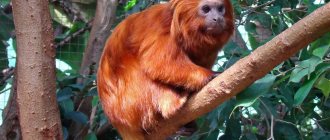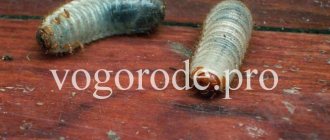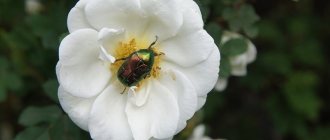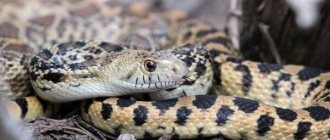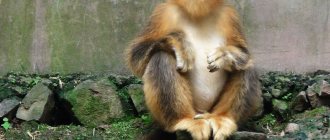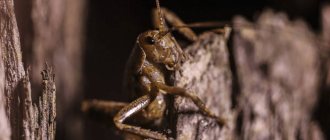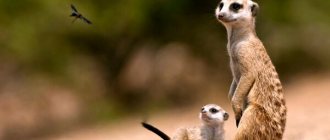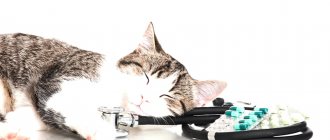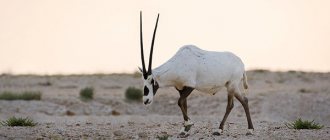The bronze beetle does not mean a specific species of insect, but rather a subfamily belonging to the family of lamellar beetles, of which there are more than 4,000 species. Most bronzebacks are inhabitants of the tropics. At least 33 species of these beetles live in Russia. The family includes not only bronze beetles, but also rhinoceros beetles. This family also includes one of the main agricultural pests – the cockchafer.
Types of bronzes
The beetles get their name from the metallic sheen of their shell. But beetles of this subfamily cannot always be identified at first glance. Some have a simple black shell without a hint of metallic sheen. The most recognizable is the golden bronze - the most widespread and numerous species in Eurasia. Some Eurasian species:
- golden;
- smooth;
- smelly;
- hairy;
- marble;
- copper.
Shamil's Bronzewort is a rare species, endemic to inland Dagestan.
Interesting facts about insects
Amazing facts about the common bronzeweed:
- beetles fly from place to place, so chemicals cannot exterminate them;
- The bronco is distinguished from the green pied by the Latin letter V on the metanotum;
- the bright emerald color with a metallic tint is formed due to the ability of the integument to scatter light;
- brightness and shine not only attract individuals of the opposite sex, but also protects them from enemies, concealing the outlines of the body;
- the frightened bronze, in self-defense, releases a sharp-smelling liquid.
The formation of the floor is influenced by the ambient temperature. In hot weather, more females emerge from the cocoons; in cool weather, more males emerge. Among bronze beetles, genetic changes are common, in which beetles of mixed sexes appear with male and female characteristics on two halves of the body.
General characteristics of beetles
The body is short. The rear line is almost straight. The transitions from the back to the sides are rounded. The head is small, directed down and forward. This family is called lamellar because of the special structure of the antennae, which, if necessary, the insect unfolds into a fan of plates.
Interesting!
The flight speed of bronze beetles is significantly higher than that of other flying beetles.
This success in bronzebacks is due to the special structure of the elytra: there are small cutouts on the sides between the abdomen and the rigid plate. Through them, insects release translucent brown wings. The elytra remain folded and do not slow down the bronco. Other beetles are forced to open their elytra, which stick out upward and to the sides during flight and greatly interfere with flight.
Fighting methods
You can scare away golden bronze from flowers with infusions of celandine and horse sorrel. But you need to be extremely careful, since a high concentration of the product can leave burn marks on the plant. If there are too many beetles on the site, then you can resort to the following recipes:
- An infusion of horse sorrel is prepared from 40 grams of crushed roots, which must be poured with 1.5 liters of boiling water. The product must be allowed to sit for at least 4 hours.
- Spraying plants with celandine has proven positive. You need to take 350 grams of fresh grass and 2 liters of hot water. The product should be infused for at least 2 days.
The strained solution is sprayed onto the plants being grown. To prevent the infusion from being washed off by rain, you need to add laundry soap or detergent. Crops are treated every five days.
It is worth noting that many pests are repelled by natural wood ash . That is why you can use the following infusion on your site: 1 glass of ash is poured with 5 liters of water. The product is infused for 2 days. After this time, you need to add a little laundry soap, previously crushed on a grater.
Coloring
The color of bronzes is very diverse. These beetles are not always beautifully colored. Even within the same species and habitat, the color of bronzes can vary greatly.
On a note!
Sometimes the coloring is formed by special highlights that completely cover the main background. The color can be with or without a metallic sheen.
Bronze beetle
With a metallic sheen, that is, shiny, oily-shiny and matte-shiny:
- green with various shades is the most common in the group;
- blue;
- copper red;
- purple;
- purple;
- bronze;
- black with a metallic sheen.
Beetles without a metallic sheen may have the following colors:
- black;
- brown;
- brown;
- red in different shades;
- green;
- yellow;
- white with an olive or gray tint.
On a note!
All members of the family have a characteristic feature: light spots, shaped like the edges of scales.
The spots may be:
- yellowish;
- clay-yellow;
- white;
- pink.
They are located on the elytra, pronotum, underside of the abdomen and upper part of the hind legs. The spots can be of different sizes and shapes. Sometimes these markings merge, covering most of the beetle's body. Most often this happens on the elytra.
Golden bronze
Another official name of the beetle is the common bronze beetle. It is sometimes called the green cockchafer. The name is completely incorrect, since these two species differ not only in color, but also in structure, as well as in the time of summer. If you compare the bronze beetle with the May beetle in the photo, photographing the insects from above and behind, you will see that the May beetle’s abdomen is much longer than the elytra and has a sharp rear tip. The elytra of the May's are ribbed and directed at a greater angle to the ground than those of the Bronze's.
The golden bronze beetle is a small beetle. Among Russian Coleoptera there are significantly larger specimens. But you can’t call her small either. The body length of the golden bronze is 13-23 mm, with a width of 8-12 mm.
Common bronze
On a note!
Golden bronze has many color variations. The only common feature: it is a beetle with a shiny metallic color. You can even find a blue beetle.
Color variations
Main color options:
- The upper part of the body is copper-purple with a metallic tint. The lower one is black with a purple sheen.
- Black without shine.
- A “regular” emerald beetle, but there are no scales on the back, only two spots.
- Iridescent beetle. The pronotum and head are emerald green with a golden tint. When lit from the side, the reflection is dark blue. The elytra are green. When illuminated from the side, they appear violet-brown. There are no white spots.
- The elytra, pronotum and head are green or golden-green. The beetle is covered with bristles.
- On the main background there are large and numerous white spots, which often merge into transverse wavy lines.
- The back and legs are golden-red or golden-green. There is a strong copper-red tint.
- Dark purple color. There are characteristic white spots on the elytra. There are no spots on the abdomen and pronotum.
- The top is copper-red or copper-brown, the bottom is bronze-green. Many spots on the elytra.
- The color on top is dark bronze or dark bronze-green. Bottom – black.
- The scutellum, pronotum and head are dark copper-red. The elytra are black and green. The lower part is black.
- Olive green color without blemishes.
- The upper side is dark purple with characteristic spots, the lower side is dark red with a strong purple sheen.
- The back is golden-green. May be copper-red.
- The upper part is green or golden green, the lower part is green.
- The top of the beetle is green, the back of the abdomen is purple-red, and the chest side is purple.
- The upperparts are golden-green or copper-red, without spots.
- Dark blue back with a green tint. There are white spots on the elytra.
- The back is bright blue, the chest is black-blue, blue-green, blue.
Bronzovka color
Bronzovkas are very “democratic” in their coloring. In addition to those listed, there are about a dozen different variations.
On a note!
Another pearlescent green beetle, the mint leaf beetle, is sometimes confused with the bronze beetle. This green bug is 2 times smaller than the bronze bug and has a convex shell shape. It eats the leaves of essential oil plants and causes much more harm than the bronze moth. But the leaf beetle belongs to a different family.
Lifestyle
Golden bronzes are distributed throughout the Eurasian continent. They are not found only in mountains and deserts. Bronzeworts eat flower cores. They have a wide menu and can damage the flowers of cultivated and wild plants. Very often they can be found on roses, where they climb into the very core. But bronzes are not capable of causing serious harm to the garden.
Interesting!
Gardeners do not like these insects, because they believe that the larva of the bronze beetle eats the roots of garden crops. In fact, plants are harmed by the larvae of the cockchafer, which are similar to the offspring of bronze beetles.
Bronzeworts are very light- and heat-loving creatures. They are active during the day in hot sunny weather. On cloudy days, bronzes are apathetic. They sit almost motionless on the cores of flowers and do not try to fly. In rainy and cold weather they hide in shelter:
- under rosettes of flowers;
- into the litter on the ground;
- under the roots of plants.
At night, beetles also descend to the ground.
The similarity between bronze beetles and May brown beetles is summer time. Bronzeworts are heat-loving and their lifespan depends on the climate in the region. In the northern regions, beetles only appear in June, while in the southern regions, the beetles begin in mid-May.
The development period of a beetle from egg to adult can take from several months to a year, depending on when the eggs were laid. If the insect has managed to develop to the adult stage by autumn, the adult overwinters in shelters and wakes up much earlier than the main summer time of this species.
What does the bronze beetle eat?
What makes the bronze beetle different from the cockchafer is its food supply. The cockchafer damages the leaves of bushes and trees. Bronzewort eats the core of flowers. The larva of the May beetle (Khrushchev) feeds on the roots of living plants. Bronzovki - rotting organic matter.
Bronze beetle nutrition
The insect eats flowers of plants from 31 families. The list includes Rosaceae, mulberry, umbelliferae, dogwood, ranunculaceae and many other families.
Larva
All larval stages of lamellar beetles are similar to each other. And the larvae of representatives of this subfamily are also so similar that it is often difficult to understand the types of insects not only from the description, but also from the photo. In order not to remember the signs that distinguish one C-shaped larva from another, gardeners prefer to fight all of them at once. Measures to combat the bronze beetle have not been developed, since it cannot cause serious harm to the crop. The years of these shiny green beetles begin after the fruit trees have bloomed. Flowers can be damaged only by individual individuals that emerge from hibernation earlier than the bulk of the bronzes.
On a note!
Some species of bronzefish in Russia are under state protection.
The larvae of these beetles process organic matter more than earthworms. As a result, the benefits from the larvae are greater than the harm from the imago. And given that three species are protected, it is easier to separate different types of larvae.
The differences between the larvae of the bronze beetle and the May beetle are clearly demonstrated by the table:
| Bronzovka | Khrushchev |
| Eats rotting organic matter | Eats living plant roots |
| Body covered with stubble | Body smooth |
| Paws short, non-functional | The paws are long, tenacious, allowing for rapid movement. |
| Body of the same diameter along the entire length | The body is strongly thickened in the caudal part |
| The head is small, inconspicuous compared to the diameter of the body | The head is huge compared to the bronze one. The diameter of the head is equal to the diameter of the body |
| Mandibles are small and weak | Powerful gnawing type mandibles |
At home, only those who are not afraid of worms and insects can figure out the larvae. The rest just kill everyone.
On a note!
You can save the future harvest by collecting adult bronzefish by hand.
Smooth bronze
Very similar to one of the variants of the golden bronze beetle - the smooth bronze beetle, listed in the Red Book of the Moscow Region. This species prefers old forests and parks where there are many rotten trees.
Smooth bronze
Distributed in Southern Europe. In Russia in the north, the border of the range passes through Kaliningrad, Voronezh, and Samara. In the south - across the border with Ukraine to Orenburg.
This beetle with a green shiny back is larger than its “relative”. Its body length is up to 3 cm. There are no white markings on the elytra and cephalothorax. The elytra have either a golden or copper-red sheen. Legs and underside of body with a bluish tint.
Life cycle
In May - June, after mating, females lay yellowish-white eggs in decaying wood, in loose soil near dead stumps, in piles of rotted manure or in anthills. After some time, fairly large white larvae hatch from the eggs, which feed on roots and various rotting remains of plants, and this plays an important role in the formation of a fertile soil layer.
Having gone through all the phases of development, the larva builds itself a cocoon, where it pupates, so that after some time it turns into a beetle. Young insects that appear in the fall remain in a cocoon for the winter, and then in the spring they begin to actively feed on pistils, stamens and flower petals. The generation is predominantly annual, but in the north of the range it can last up to 2 years.
Marble
An analogue of the golden bronze with a green shell decorated with white markings. The marbled fish often has a greenish tint to its shell. The body size is slightly larger: up to 27 mm.
Distributed throughout Eurasia, except for the mountain forests of the Caucasus and Crimea. Prefers lowland forests. Settles on old trees. The species is numerous, but insects are found alone. These beetles are active from June to August in the European part of Russia and from mid-May to mid-August in Ukraine.
The life cycle in warm regions takes 1 year, in northern regions – 2 years. Females lay eggs in old stumps of some tree species.
Smelly
Other names: spotted deer or fetid deer. A small shiny black beetle. Body size up to 13 mm. There are many small white spots on the elytra. The body is covered with white dense bristles. Lives in warm regions, including southern Russia.
An agricultural pest, as the larvae eat plant roots. The adult feeds on pollen. Summer begins in May.
Types of bronzes
Food preferences
The harm this insect causes becomes clear from what the bronzeback eats.
Pest food preferences:
- flowers (especially light ones);
- young fruits;
- ovary of plants or fruits;
- first leaves.
The beetles completely eat up the stamens and pistils, so sexual reproduction of seed plants becomes impossible, and the yield sharply decreases. It is not surprising that gardeners and gardeners are looking for effective ways to deal with bronzes.
If the bronze fly gets into the house, then its food becomes indoor plants.
